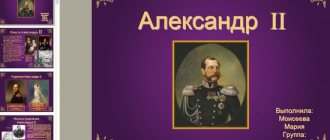Lesson outline. Lesson topic: Domestic policy of Alexander I
Russia faced the need for transformation.Who was the emperor at the beginning of the 19th century?
Lesson topic: “Internal policy of Alexander I”
1.Let's get acquainted with the personality of the young emperor
called the first half of the reign of Alexander I “the days of Alexander a wonderful beginning.” Indeed, the emperor was full of plans and hopes for a speedy change in life in Russia. Let's turn to the materials in paragraph 2 and find the answer to the question, what were the liberal aspirations of the emperor connected with?
2. Unspoken committee.
To implement his reform plans, the young emperor had to rely on trusted people. These became the count, his cousin, the prince, the count. These people became part of Alexander’s circle of close friends, which was called the “Unspoken Committee.”
Let's read what were the first laws passed with the participation of the “Secret Committee”?
In whose interests do you think these decrees were carried out?
In addition, the king created an Permanent Council of 12 people, which was supposed to develop and discuss the most important bills.
What do you think Russia could come to?
3 First transformations
Already on April 2, 1871, Alexander I issued a number of important decrees:
1) He restored in full the Charter to the nobility and the Charter to the cities.
2) Abolished the secret expedition and transferred the most important court cases to the Senate for consideration.
3) On May 28, 1871, a decree was issued banning the publication of advertisements for the sale of serfs without land.
How did the emperor treat the peasants?
4) Alexander granted the right to the burghers and peasants to buy uninhabited lands?
5) In September 1802, the reform of the highest bodies of state power began. Let's look at the diagram. To replace Peter's colleges, 8 ministries were created; all members of the Secret Committee joined the government
6) In 1801, Alexander I opened a university in Dorpat (Tartu), in 1804 - in Kazan. In 1803, the Universities were granted significant autonomy (i.e. independence)
7) On February 20, 1803, Alexander I adopted an important decree on “free cultivators”
4 Speransky
in 1809. Developed the project “Introduction to the Code of State Laws.” Speransky wanted to gradually lead Russia to a constitutional monarchy;
Speransky hoped to introduce
system of separation of powers.
Although the emperor approved the project, he was at the same time afraid of the indignation of the nobility and therefore only adopted a decree on the creation of the State Council
January 1, 1810. However, this decree also caused discontent. Speransky was dismissed and exiled to Nizhny Novgorod.
Lesson summary on the History of Russia on the topic “National Policy of Alexander I” (grade 9)
NATIONAL POLICY OF ALEXANDER I
Material for independent work and project activities of students
What is national policy? What were its features under Alexander I?
The Russian Empire was a multinational state inhabited by representatives of different nations.
During the reign of Alexander I, new lands were included in Russia.
In addition to the Polish territories (populated mainly by Poles and Jews), lands inhabited by Finns and Swedes were annexed.
The Baltic states also had a special status
, which has been part of the country since the 18th century. Throughout the 19th century, Russia advanced into the Caucasus, taking power over its many peoples.
Development of those annexed to Russia at the end of the 18th century. Novorossiysk and Kuban lands caused a flow of immigrants not only from the central regions of the country, but also from abroad.
Under Alexander I, Bulgarians, Greeks, Serbs, Gagauzians, and Germans settled in the Northern Black Sea region.
When carrying out reforms, it was necessary to take into account the characteristics of different regions and to pursue a balanced national policy in relation to each of the peoples.
1. Finland as part of Russia
In 1809, following the results of the Russian-Swedish war, Russia annexed the territory of Finland. This region, called the Grand Duchy of Finland, immediately received a special status within Russia. Finland was endowed with quite a lot of independence in governance, had its own Sejm (a meeting of representatives of all classes), without whose consent not a single law could be issued, amended or repealed.
To govern the Grand Duchy of Finland, the Tsar appointed a Governor-General (as a rule, he was a member of the Baltic nobles). He, in turn, headed the Main Administration Committee (the highest administrative institution of 12 local residents - 6 nobles and 6 non-nobles). All paperwork had to be conducted, as before, in Swedish. A Government Council was also created to manage the court and state economy. The education system and local government system remained autonomous. All official appointments in the region were carried out by the emperor. The city of Vyborg and its surroundings were annexed to the Grand Duchy of Finland.
This policy of the authorities made it possible to ensure the relatively calm development of Finland as part of the empire.
2. The Kingdom of Poland and its constitution
The Poles became the third largest people in the country (after the Russians and Ukrainians), and the Jews (who inhabited Polish lands in large numbers) became the fourth.
The Kingdom of Poland, formed in 1815, had significant independence.
According to the constitution, the head of the Kingdom of Poland was the Russian emperor, he had to take an oath of allegiance to the adopted constitution.
Legislative power belonged to the king and the Sejm, which consisted of two chambers.
The lower house of the Sejm was elected from the cities and from the nobility. Suffrage was limited by age and property qualifications.
The Sejm did not have the right to pass laws; it could only submit an appeal to the emperor proposing the adoption of certain laws.
All draft laws had to be discussed in the State Council.
The Constitution of the Kingdom of Poland guaranteed personal integrity, freedom of the press, obliged the use of the Polish language in government institutions, and appointed only Poles to government, judicial and military posts.
The adoption of a liberal constitution, very progressive for that time, led the Polish nobility into a state of delight and instilled hopes for further strengthening of the independence of the Kingdom of Poland and the expansion of its territory at the expense of the Ukrainian and Belarusian lands of the former Polish-Lithuanian Commonwealth.
Thus, attitudes towards the constitution were different: the Poles considered the adoption of the constitution the beginning of the path to complete independence, and Emperor Alexander I believed that he had already done too much for Poland.
This contradiction caused the formation of a powerful Polish national liberation movement, which unfolded in subsequent decades (for more information, see pp. 80, 147), becoming a source of many problems for the authorities.
Windmill in the Baltics
3. The Baltic states as part of Russia
The emperor's reform activities also affected another national outskirts of the Russian Empire - the Baltic region.
Baltic peoples at the beginning of the 19th century. lived in three western provinces of Russia - Estland, Livonia (annexed back in 1721) and Courland (became part of the empire during the third partition of the Polish-Lithuanian Commonwealth).
The peasant question here was complicated by pronounced national contradictions: the majority of landowners in the Baltic states were of German origin, while the ancestors of modern Estonians and Latvians were peasants.
Alexander I tried to soften the situation.
In 1804, by his decree, all Baltic peasants were recognized as attached to the land, and not to the landowner, and their sale without land was prohibited. Peasants were declared the owners of their plots, they could transfer plots of land by inheritance.
The arbitrariness of landowners in relation to farmers was also weakened; lists of duties were drawn up for each estate. Peasant farm laborers who had no land found themselves in a difficult situation.
This law turned out to be disadvantageous for the Baltic nobles, who lost part of their lands, and in 1816-1819. In the Estland, Livonia and Courland provinces, Alexander I carried out a new reform.
Here the serfdom of the peasants from the landowners was abolished - the peasants received personal freedom, but lost all rights to their land plots.
Landowners were declared the owners of the land, while peasants could only rent land from the landowners. According to the reform, peasant volost communities and peasant courts were created, the activities of which, however, were also controlled by landowners.
4. Peoples of the Caucasus
The map of the peoples of the Caucasus has always been extremely varied. By the beginning of the 19th century. more than 50 peoples lived here - representatives of a wide variety of language families: Armenian (Armenians) and Iranian (Ossetians, Kurds, Tats) groups of the Indo-European family, Kartvelian family (Georgians), North Caucasian family (Abkhazians, Abazas, Kabardians, Circassians, Adygeis, Shapsugs, Chechens, Ingush, Avars, Laks, Dargins, Tabasarans, Lezgins, Aguls, Rutulians, Tsakhurs), as well as the Turkic (Kumyks, Nogais, Karachais, Balkars, Azerbaijanis) group of the Altai family.
Caucasian landscape with highlanders. Artist M. Yu. Lermontov
Tiflis. Artist M. Yu. Lermontov
Circassian. 19th century drawing
These peoples spoke different languages and professed different religions (Christianity among Georgians, Armenians, Ossetians, Sunni Islam among the majority of mountain peoples, Shiite Islam among some Dagestanis and Azerbaijanis).
The mountain tribes were engaged in cattle breeding, as well as auxiliary crafts - hunting, fishing. Most of them were dominated by tribal relations.
The entire first quarter of the 19th century. took place under the sign of the expansion of Russian possessions in the Caucasus.
Each of the kingdoms, principalities, khanates and sultanates located here had its own history of becoming part of the empire: some made such a decision themselves, others fought wars of independence with Russian troops.
The annexation of the Caucasian territories to Russia, on the one hand, reliably protected them from attempts at subjugation by Turkey and Iran. The interaction between the economy and culture of the peoples of the Caucasus and Russia began, which was mutually beneficial. The Russian military and civil administration acted as an arbiter in centuries-old interethnic and tribal disputes. On the other hand, the inclusion of such a complex region into the empire became the source of many internal problems in the future, and also exacerbated Russia’s contradictions with its southern neighbors. The introduction of a new management system and cultural customs, the penetration of immigrants from Russia often caused protests from the local population. Finally, the development of new lands required huge expenses from the treasury, which diverted funds from the development of the central regions of Russia.
5. Population of Siberia
The population of Siberia gradually grew: if at the beginning of the 19th century. About 200 thousand people lived here, then by the middle of the century there were already 600 thousand. Residents from the central regions moved here, but this created a threat that the local peoples would lose their original features.
All non-Russian peoples of Siberia were called at that time the term foreigners.
Many of these peoples retained remnants of tribal relations.
They actively moved across vast expanses. The Mansi and Nenets moved east, occupying the lands of the Enets. The Selkups moved south along the Yenisei. The Tungus (Evenks) settled to the north-west, and the Chukchi pressed the Yukaghirs. The Yakuts, whose numbers were growing rapidly, noticeably expanded their territory of residence.
The process of forming new peoples was actively underway. The economic and cultural proximity of the tribes living in Tuva became the basis of their ethnic community. The tribes of Koibals, Kachins, Beltirs, Sagais, and Kyzyls who lived in the Minusinsk Basin made up the Khakass people, and the Mongol-speaking tribes of the Baikal and Transbaikalia regions made up the Buryat people.
All this required from the authorities, on the one hand, a careful attitude towards the peoples of Siberia, and on the other, the inclusion of all its indigenous inhabitants in the economic and cultural life of Russian society.
In order to streamline the management of foreigners, in 1822 the Charter on the management of foreigners was adopted, prepared with the active participation of M. M. Speransky (who was then the Governor-General of Siberia). Indigenous peoples, according to this document, were divided into three categories - wandering, nomadic and sedentary.
Settled foreigners were completely equal in their rights to state peasants; they bore all the same duties. These were the Tatars, Altaians, Shors, southern Khanty and Mansi, etc.
The wandering foreigners (Nenets, Koryaks, Yukaghirs and other hunting peoples) were ruled by “princes” from among the local tribal elite.
Nomadic foreigners (Buryats, Yakuts, Evenks, Khakass, etc.) also received similar control. The territory of their settlement was divided into uluses and camps.
The Charter provided for the gradual transition of wandering and nomadic peoples to settled ones and, as a result, their equal rights with the Russian peasantry (with the exception of military service, which foreigners were not supposed to perform).
The Charter was the most progressive document for its time in relation to indigenous peoples, which had no analogues in any state of that time.
LET'S SUM UP
In the first quarter of the 19th century. The national composition of the population of the Russian Empire expanded significantly. The authorities were faced with the need to build a national policy taking into account the interests of not only the largest, but also small nations. On this path, the government of Alexander I achieved significant successes, the most striking of which was the adoption of the Constitution of the Kingdom of Poland in 1815 and the Charter on the Administration of Foreigners in 1822.
Questions and tasks for working with the text of a paragraph
1. Using the text of the paragraph, prove that the Grand Duchy of Finland had special conditions of governance and independence within the Russian Empire. 2. Compare the national situation in Finland and the Caucasus. What is the main difference you can think of? 3. Who in the 19th century. called foreigners? 4. What features existed in the management of Siberia in the first quarter of the 19th century? What caused them? 5. Tell us about the peculiarities of the position of the Baltic states within the Russian Empire. 6. Did the situation of the Baltic peasants differ from the situation of the serfs of the main part of the country?
Working with the map
1. Using the map, determine what significance the annexation of Finland and part of Poland had from the point of view of the geographical location of Russia.
2. Compare using a map of the territory of the Polish-Lithuanian Commonwealth in the 1760s. (on the eve of the partitions) and the territory of the Kingdom of Poland in 1815.
We think, compare, reflect
1. Name the nationalities and nationalities that were part of the Russian Empire in the first half of the 19th century, which are mentioned in the paragraph. Prepare a report about one of the peoples of the Russian Empire.
2. Compare the position of Finland and Poland within the Russian Empire, find commonalities and differences.
3. Prepare abstracts for the discussion on the topic “Positive and negative aspects of the annexation of the Caucasian lands to the Russian Empire.”
4. Using Internet materials, make a presentation about the culture and traditions of one of the peoples of the Caucasus mentioned in the paragraph.




